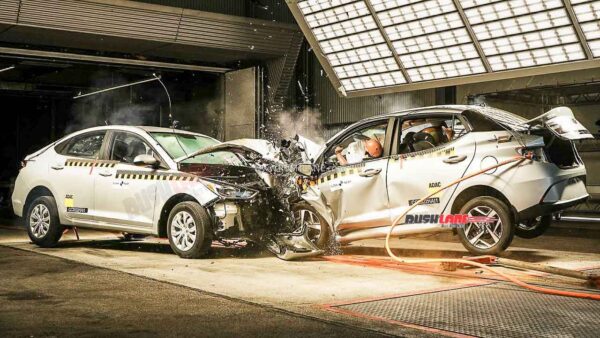Hyundai Aura India Made Vs Verna (US Market)
[ad_1]
Car to car crash tests make things crystal clear, which should help consumers understand the choices they make

As part of its mission to standardize car safety equipment across the globe, Global NCAP has been working on a number of initiatives. By 2030, the organization is aiming for all cars to be equipped with safety features such as electronic stability control, crash avoidance technologies and intelligent speed assistance. Another key objective is to have all cars comply with minimum crashworthiness standards.
As of now, car safety standards vary significantly from country to country. While developed countries have strict regulations, safety standards in emerging economies and low-income countries have a lot to catch up. To highlight the difference in safety standards based on geography, Global NCAP has carried out a car to car head-on collision between Hyundai Grand i10 sedan (Aura) and Hyundai Accent.
NCAP car to car crash test
For this test, one of the cars used is a Grand i10 sedan sold in Mexico and manufactured at one of Hyundai’s plants in India. The other car is Hyundai Accent sold in US and manufactured in Mexico. Both these cars are among the cheapest sedans that are available in the respective countries. Results of the crash test clearly demonstrate the difference in safety standards followed by carmakers in different countries.
While Accent has safety features such as electronic stability control (ESC) and 6 airbags, the Aura model sold in Mexico is equipped with only two front airbags. In the crash test, Hyundai Accent provided marginal to good safety for the driver. The structure was found to be stable.
In comparison, Hyundai Aura provided ‘weak’ to ‘poor’ protection for the driver. The car’s structure was compromised and it’s likely that the driver would have suffered major, life-threatening injuries. Such a car would have received zero-star rating by Latin NCAP.
While one can write lengthy articles about differences in car safety standards, a car to car crash test makes things much easier to understand. NCAP is working with governments and carmakers globally to ensure that safety equipment is standardized for all countries. It will help save lives and reduce the risk of serious injuries.
Practical challenges
While standardizing car safety equipment across the globe is a virtuous goal, it may run into practical problems. For example, the purchasing power of an average car buyer in a low-income country will be significantly less in comparison to that of his counterpart in a developed country. The former is unlikely to be able to afford a car that comes with advanced safety features.
If carmakers in emerging economies and low-income countries use the same yardstick as that of developed countries, cars will become inaccessible for a large segment of users. Users may be forced to use two-wheelers or buy second-hand cars that may be even worse in terms of safety. The idea of standardization of safety standards globally will be easier to implement in a world where all countries are equally placed economically. That’s unlikely to happen anytime soon.
[ad_2]
Source link










